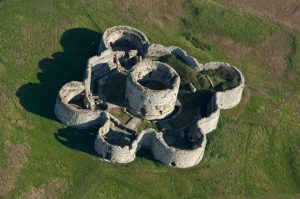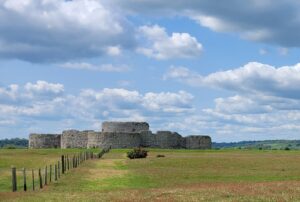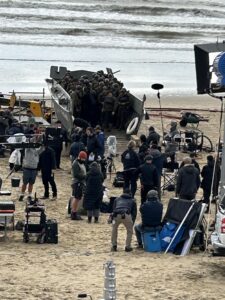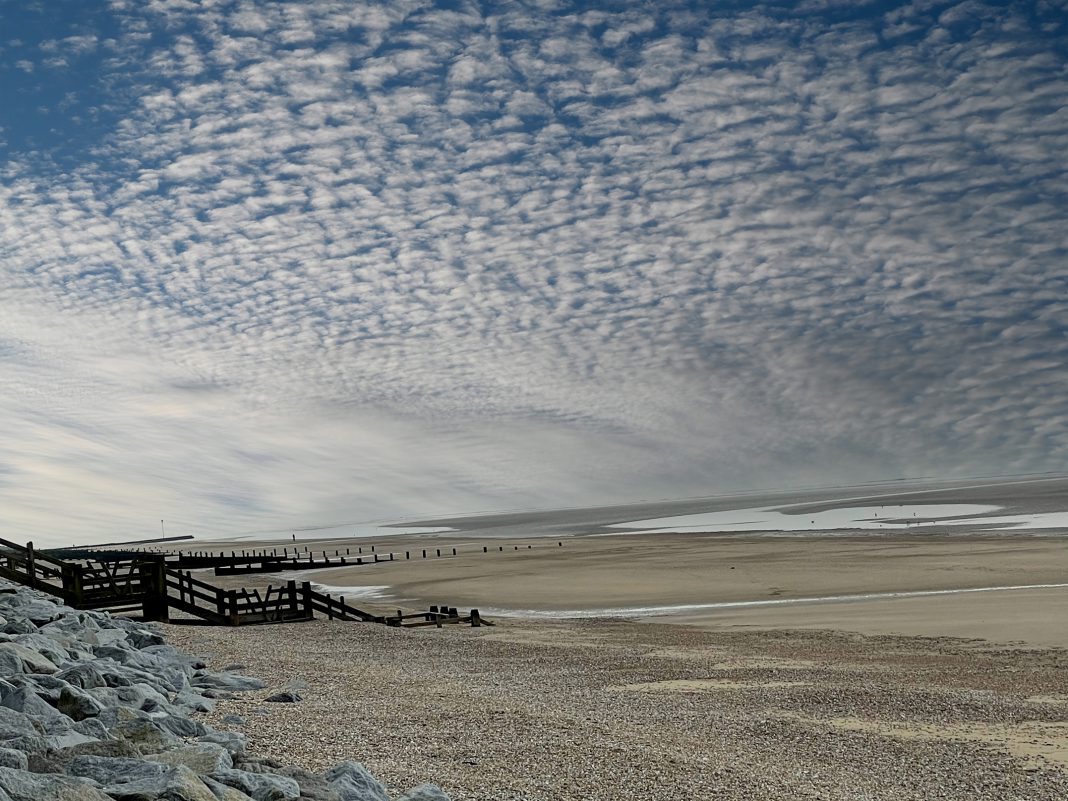Just three miles southeast of Rye is a unique stretch of land, Camber Sands. Unique because it is the only area of sand dunes in East Sussex. Stretching along the coast for about five miles, it is the UK’s longest sandy beach east of Bournemouth, and one of the relatively few sand beaches in either East or West Sussex.
The root of the name Camber is French, a chambre, a room, and refers to the bay formation bordered originally by Old Winchelsea, Old Romney and Rye. Over the years, before spelling was standardised, it had a number of similar variations, from Camere in 1375, Portus Camera originally in 1497 and reverted to in 1456 and 1519, Caumbre in 1442 and, after a number of changes, Camber Point in 1747.

Early in the 16th century, between 1512-14, at the end of one of the then plentiful shingle banks that were present in the Camber, Sir Edward Guldeford built a circular tower. The intention was to defend the harbour – but as no cannon were added, it is rather difficult to guess how that would be managed. Although now called Camber Castle, when in 1539, by order of King Henry VIII, a reconstruction began, its original name was Winchelsea Castle. Its method of construction would be greatly approved of by ecologists, as much of the building material was sourced locally, so its carbon footprint would have been somewhat reduced – but not entirely! Wood for support was felled in Beckley and Appledore, quarries at Fairlight and Hastings supplied some of the stone, whilst demolished buildings in Winchelsea, including the church of St. Thomas were used as a quarry. About 600,000 bricks were made on site. However, some of the limestone dressings came from Caen, in Normandy. This was far from unusual; Caen stone had already been used on the Tower of London, Canterbury Cathedral and Westminster Abbey.
An Act of Parliament dated 1541 ensured that all castles and forts in Kent and Sussex were to be commanded by Sir Thomas Cheyne, who held the posts of Lord Warden of the Cinque Ports and Constable of Dover Castle. The castle was ready in 1544, at a cost of £23,000. Records show us that it was fully manned by 1553, with a captain, deputy captain, 16 gunners, nine soldiers and a porter. By the end of the 16th century it was, at least for the purpose of defence against attack by sea, redundant, due to the silting up around the coast. It was abandoned in 1637, stripped of its cannon in 1642, and partly demolished.

Camber can claim to have been the site of one of the first private aerodromes in the country. Known as Camber Sands, it was set up and operated by Lieutenant-Colonel Alec Ogilvie, a friend of Orville and Wilbur Wright, between 1909-11. He had a biplane delivered, (for those AV geeks it was a Short-Wright No. 2, manufactured by Shorts under licence from Wright,) in September 1909. Just a year later, flights lasting 10 minutes were being made from Camber. Flight times increased as experience did, so that in December 1910, a flight of 142 miles was made in just under four hours. The lease on the Camber site expired in May 1911, and was not renewed.
There was some aerial excitement for Camber during the Second World War, when on October 25 1940, at 9.30 in the morning, a Messerschmitt fighter, piloted by Oberleutenant Joachim Schypek, crash landed at Broomhill Farm. The pilot was arrested. Another did the same at Camber Farm, and again, the pilot, named Bock, was arrested. Another Messerschmitt crashed on Camber Sands and burst into flames, with the unfortunate pilot being seen to burn to death. The crash happened in a minefield, so rescue was impossible. A Junkers bomber was shot down, landing in the Channel, four miles off Camber, with the loss of its crew of four. In 1944, an American Liberator bomber crashed at a farm near Camber. Happily, all the crew baled out, with just one injury.
Tom Holt’s Mapp and Lucia tribute book, Lucia in Wartime, published in 1985, includes an episode where Lucia ‘captures’ the pilot of a fighter that has crashed just outside Rye. She ends up bashing him with a cucumber, and then he is arrested by Major Benjy and his Home Guard. Sadly, for them all, he isn’t German, but a Polish officer, related to the Polish royal family. His language, Polish obviously, was mistaken for German by Lucia – to her embarrassment, as she was believed (but not by Mapp,) to be speaking Polish rather than Italian for the duration.
During the war the sand dunes were mined and fortified, with some land being reserved for military training. This was because some of it was similar to the coastline of Normandy. The similarity was useful for film production crews, with Camber again standing in for France in the 1958 and 2017 films that featured the evacuation of Dunkirk in 1940.

The beach was also used for filming in 2024. Pressure, starring Andrew Scott and Brendan Fraser, tells the story of Britain’s chief meteorological officer James Stagg, whose job it was to monitor the UK’s unpredictable weather conditions ahead of the Normandy invasion.
You can read about last year’s filming in this Rye News story.
Image Credits: Kt bruce , Barbara van Cleve [CC BY-SA 4.0] https://commons.wikimedia.org/wiki/File:Camber_Castle_from_the_air.jpg Creative Commons Attribution-Share Alike 4.0 International https://creativecommons.org/licenses/by-sa/4.0/deed.en, Juliet Duff , Amanda English .




Although not a reply to the above I would like to relate my experience of a visit to Camber Sands when I was young boy in the 1940’s.
Having only had day coach visits to Southend I couldn’t believe that huge beach of white sand with hardly anybody on it. It was magical virtually having the whole beach to ourselves. I distinctly remember chimney stacks sticking out of the dunes that had overrun some of the houses. I also remember there was no running water, which had to be tanked in, and had to be bought from a shop.
Years later I used to cycle there, from London, with my friends and camp next to a ‘Walkers Cafe’ which used to be there.
Are there any photos showing engulfed houses with just the chimney stacks sticking out of the dunes.
Regards
Roy Balding
My late stepfather told me the same story,after a really bad storm the bungalows going down on the right hand side towards the central carpark were completely engulfed in sand, and if the sand dunes are ever pushed back from the road,I’m sure there is real treasure in those bungalows awaiting to resurface.
I remember in the early 40s holidays at camber sands. A rented house owned by a Mrs Clutterbuck number 2 Marine Parade on the seafront. She lived in number1.Sea defences were still on the beaches. Concrete machine gun lookouts still there. Work was ongoing to dismantle them.
It was a very noisy week. But memorable.